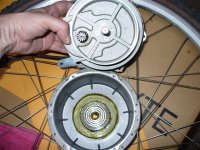kbarrett
10 kW
Might not wish so fast there ....
I have a very pretty, and pretty useless Heinzemann.
It looks like that loose gear I was worried about was too loose.
Power is applied, and everything spins up ... but if there is the slightest amount of torque needed, it just slips and won't go forward.
The motor spins, but the first gear in the train just slips and spins.
So ... I need to talk to heinzemann ... and maybe deardancer3?
I didn't see "as is" on that sale. I've spent a bit of change here getting this beast ready ... for nothing apparently. Any clue about how to fix this?
I have a very pretty, and pretty useless Heinzemann.
It looks like that loose gear I was worried about was too loose.
Power is applied, and everything spins up ... but if there is the slightest amount of torque needed, it just slips and won't go forward.
The motor spins, but the first gear in the train just slips and spins.
So ... I need to talk to heinzemann ... and maybe deardancer3?
I didn't see "as is" on that sale. I've spent a bit of change here getting this beast ready ... for nothing apparently. Any clue about how to fix this?


